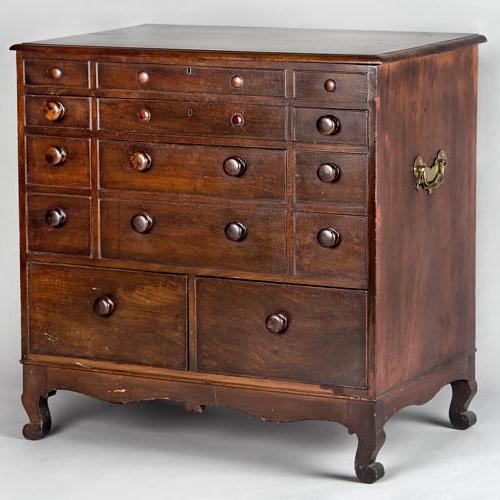Collections Online
Sea chest belonging to Benjamin Joy
To order an image, navigate to the full
display and click "request this image"
on the blue toolbar.
-
Choose an alternate description of this item written for these projects:
- Staff Favorites
- Main description
[ This description is from the project: Object of the Month ]
This fitted sea chest was used by Benjamin Joy, an East India merchant who served as the first U.S. Consul to India. It was probably made in India and accompanied Joy on his return voyage to Boston.
Who was Benjamin Joy?
Benjamin Joy was born in Boston in 1757, the son of John Joy, a merchant and housewright, and Sarah Homer. John Joy was closely associated with the unpopular administrations of colonial Governors Thomas Hutchinson and Thomas Gage and in 1776 left Boston (from which he was later banished), fleeing to Halifax and later to England. After the revolution, John remained in England, but his sons John and Benjamin returned to America where John, an apothecary, and Benjamin, a merchant, settled in Boston. John Joy built his “country estate” on almost 2 ½ acres bounded by present day Beacon, Walnut, Mt. Vernon, and Joy streets that were once the “elm pasture” of witchcraft trial Judge Samuel Sewall. Joy Street (formerly Belknap Street) was formally adopted as the name of the street that bounded the northern side of his property in 1851.
In 1792, Benjamin Joy, who had made voyages to India after the American Revolution, was appointed consul to India by President George Washington. He arrived in Kolkata (formerly Calcutta) in April 1794. Although the British East India Company did not recognize Joy’s status, this marked the beginning of diplomatic relations between the United States and India.
After brief service as consul, Joy returned to Boston, where in 1797 he married Hannah Barrell, the daughter of Joseph and Hannah Barrell. Together they had 12 children. In 1808, Benjamin purchased the property of the First Church on Cornhill Square, on which he erected “Joy’s Building,” a Boston mercantile landmark for decades. He was also a member of the “Mount Vernon proprietors,” a group that acquired and developed the land of Loyalist John Singleton Copley on Beacon Hill. From Copley’s vantage point in England, the land seemed like a worthless cow pasture, but, due to the impending (unknown to Copley) construction of the Massachusetts State House, was in fact quite a valuable parcel. Benjamin died in Boston 14 April 1829 and is buried in the Old Granary burying ground.
Benjamin Joy’s sea chest
Portable chests were indispensable on long sea voyages. In 1795, Benjamin Joy’s voyage from Kolkata to Boston took 216 days and his chest would have proved both useful and luxurious. Made of mahogany (suggesting Indian manufacture) with brass fittings and Wedgwood porcelain, this chest provides a felt-covered writing surface, secure compartments to hold ink and other liquids, more compartments for brushes and a sewing kit, a wash-basin, mirror, drawers, chamber pot, and even a bidet. The chest was given to the Massachusetts Society in 1951, by another Benjamin Joy, the great-grandson of the original owner.
For Further Reading
Arora, Anupama and Rajender Kaur, editors. India in the American Imaginary, 1780s-1880s. Palgrave Macmillan, 2017
Bean, Susan S. Yankee India: American Commercial and Cultural Encounters with India in the Age of Sail 1784-1860. Salem, Mass.: Peabody Essex Museum, 2001.
Bhagat. G. Americans in India: 1784-1860. New York: New York University Press, 1970.
Joy, Benjamin. Papers. Massachusetts Historical Society.
--The Massachusetts Historical Society manuscript collection includes letters from Benjamin Joy to George Cabot and others describing his service in India and decision to resign and return to the U.S.
--The Benjamin Joy Papers, 1801-1823, relate to his investment in later voyages to South America.
--The George Joy Letters, 1791-1836, are letters received by Benjamin’s brother George, who remained in England, and include letters from Benjamin.
Joy, James Richard. Thomas Joy and his Descendants. New York: Printed for the family, 1900.
Stark, James H. The Loyalists of Massachusetts and the Other Side of the American Revolution. Boston: J. H. Stark, 1910

